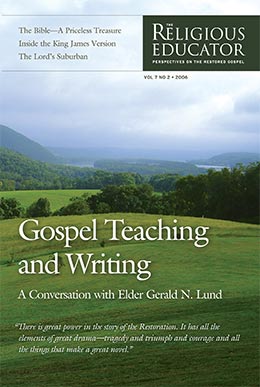Editors' Introduction
Are writers naturally born, or can they hone their craft? How can writing be a venue for teaching the gospel? Elder Gerald N. Lund answers questions like these and shares ideas from his twenty-plus years of publishing and even longer experience as a gospel teacher.
The Old Testament is the focus in Sunday School this year, and we offer several articles featuring different aspects of the Bible, including its translation into English. Each takes a different approach, but, in the words of President Gordon B. Hinckley, they “seem to harmonize, one with another, each a thread in the tapestry of a grand and beautiful pattern” (Discourses of President Gordon B. Hinckley, vol. 2 [Salt Lake City: Deseret Book, 2005], 89–90).
Latter-day Saints sometimes undervalue the Holy Bible as the original testament of Jesus Christ. In “The Bible: A Priceless Treasure,” David M. Whitchurch shares accounts of the origins of our Bible, testifying of its importance in our canon of scripture. Next, Kent P. Jackson, Frank F. Judd Jr., and David R. Seely team up to provide a comprehensive and insightful look at the grammatical nuances of the Bible, including “Chapters, Verses, Punctuation, Spelling, and Italics in the King James Version.” Many Reformers gave their lives in defending the Bible and its truths. Stephen J. Fleming calls attention to an overlooked aspect of the Reformation, identifying the Anabaptists and other Radical Reformers as forerunners to the Restoration.
In “Kindness: An Outward Expression of True Conversion,” Kendall Ayres identifies the problem of self-righteousness and suggests that when we are truly converted to the gospel of Jesus Christ, we will reflect that light and attract others to the gospel.
Gospel teachers do not always realize what an impact they have, and the most important teaching takes place at home. M. Steve Andersen describes the profound effect his great-grandmother had in shaping his views of the Book of Mormon. Then Rebecca McConkie offers a tribute to gospel teachers in her life, describing the positive influence of her father’s love for the gospel and the effect that teachers who had paid the price of learning had on her.
From the fall of a sparrow to the majestic flight of an eagle, the Savior often used birds as symbols of spiritual qualities. Dale Z. Kirby discusses these beautiful creatures and their symbolism in “‘The Way of an Eagle’: Birds in the Scriptures.”
Don and Ann Pearson, parents of six children, share their experiences in instilling a love of learning through the “small and simple things” of parenting. Then, in “Blessed by Seminary,” Robert Hasara talks about the role of peers in leading him to the gospel, including early experiences while attending seminary.
In “The Lord’s Suburban,” Jeanne Boren teaches that even material possessions should be viewed as blessings from God that we should be willing to share with one another.
How well does God know His children? Is He merely guessing at the outcome of their lives? Roger K. Terry clears up some misconceptions about the omniscience of God, suggesting that such an understanding is essential for us to have faith in our Heavenly Father.
We close with “Profiles of the Prophets: Wilford Woodruff,” a look into the life of our fourth President of the Church.
Richard Neitzel Holzapfel, Editor-in-Chief
R. Devan Jensen, Executive Editor
Ted D. Stoddard, Associate Editor
